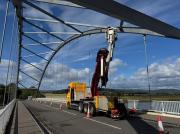Council welcomes Scottish Government's infrastructure plans
7th December 2011
The Highland Council has welcomed the Scottish Government's plans for substantial investment in Scotland's rail network; the dualling of road network between all of Scotland's cities, including the A 9 Perth - Inverness and the A96 Inverness - Aberdeen road; and the upgrading of the A 82 between Fort William and Crianlarich.
The Cabinet Secretary for Infrastructure and Capital Investment, Alex Neil, made the pledge as he published the Scottish Government's Infrastructure and Investment Plan, which details plans for up to Ł60 billion of spending right up until 2030.
Councillor John Laing, Chairman of the Council's Transport Environmental and Community Services, said: "Effective transport communications are vital to the future prosperity of the Highlands so this commitment to improving our roads and rail network is hugely encouraging.
"As ever the proof of the pudding will be in the eating, but this aspiration to invest in our infrastructure must be warmly welcomed.
"Our priority will be to see dualling of the A 96 between Inverness and Inverness Airport; the construction of a major new link from the A96 at Smithton to the A9 and a by-pass of Nairn.
"We also recognise the need for improvements on the A9 north of Inverness, particularly at Berriedale Braes and on the A 82 between Inverness and Crianlarich and improvements in the rail network to speed up travel to Aberdeen and the south."
The Scottish Government's Infrastructure and Investment `plan includes 54 major infrastructure projects and 33 programmes, across a range of areas, including schools, hospitals and housing.
Key points include:
•Transport - the Scottish Government will dual the A9 between Perth and Inverness by 2025, with a view to completing dualling of the A96 and the dualled road network between all our cities by 2030; complete construction of replacement crossing over the Firth of Forth by 2016, and invest in substantial rail improvements, reducing journey times between Edinburgh and Glasgow, from Aberdeen to the central belt, Aberdeen to Inverness and on the Highland Main line
•The plan includes high speed rail, and estimates a cost of Ł15 billion for completion of the route, from North West England to Scotland, with a Scottish contribution of Ł8 - 9 billion. Minister's will continue to press for this to come to Scotland at the earliest opportunity, although final decisions on timing and route rest with the Westminster Government
Related Businesses
Related Articles
Exciting Career Opportunities With The Highland Council Now Open For Applications
# 10 December 2025 Career opportunities with The Highland Council The Highland Council is looking to fill a variety of posts relating to civil engineering and flood risk management based in locations across the area. Included are opportunities specifically for civil engineering graduates and technicians, providing the ideal job with career progression for anyone recently qualified and ready for a varied and interesting role.
What the NC500 Research Projects Are Designed to Do - and Why They Matter for the Highlands
As the North Coast 500 approaches its tenth anniversary, it has become one of Scotland's most well-known tourism success stories. The 516-mile loop around the far north of the Highlands has been celebrated internationally, marketed as a world-class road trip, and credited with transforming visitor numbers in some of Scotland’s most remote areas.Help Shape the Future of Thurso
The Highland Council is inviting people that live, work, or study in Thurso, to come along to the public consultation events to have their say. This is an opportunity to help shape the future of Thurso, to gather views and ideas.
Are Scottish Councils Quietly Reversing Outsourcing? A Look at Insourcing, Cuts and the Highland IT Shift
A notable article in the Guardian on 6 December 2025 noted the high sums being paid by London councils outsourcing services to private firms. The article starts with the reduction in council funding by UK government since 2010.Council welcomes Visitor Levy flexibility plan
The Highland Council welcomes moves by the Scottish Government to introduce greater flexibility on how it could design a Visitor Levy Scheme for consultation. The Visitor Levy (Scotland) Act 2024 currently provides local authorities with discretionary powers to implement percentage-based levies following statutory consultation.Highland Council is reaching out for views to shape its next 26/27 budget.
As it looks to set out its forthcoming priorities, the council is seeking involvement from members of the public, including businesses, community groups, parents, and young people. All their opinions are going to be crucial in deciding how Highland Council will take on its budget challenge for 2026-2027.Have your say in Thurso's future ÂŁ100million investment by attending public consultation events
Thurso is to benefit from ÂŁ100m investment in education and community facilities and are rolling out the first phase of public consultations on 9 and 10 December 2025. The Highland Council is inviting people that live, work, or study in Thurso, to come along to the public consultation events to have their say; this is an opportunity to help shape the future of Thurso, to gather views and ideas.Finding new owners for empty homes - Scheme launched to help return more empty homes to active use
A new online portal has been launched to bring empty homeowners together with prospective buyers or developers with the aim of facilitating more properties to be used as homes again. Covering the whole of Scotland, this builds on the success of local pilots, referred to as "matchmaker schemes".Consideration for short term let control area in Skye and Raasay
Steps towards introducing a short term let control area have been considered by Highland Council's Isle of Skye and Raasay area committee. On Monday (1 December 2025) the committee heard evidence to justify the grounds for the introduction of a Short Term Let Control Area covering all or part of Skye and Raasay.Workforce North event spotlights Highland economy
EMPLOYERS and educators from across the Highlands have gathered to hear how a new initiative is aiming to transform the region's economy. Workforce North - A Call to Action brought together business leaders and teachers from primary and secondary schools from across the Highland Council area with a wide range of partners geared towards education, learning and skills development at Strathpeffer Pavillion.
